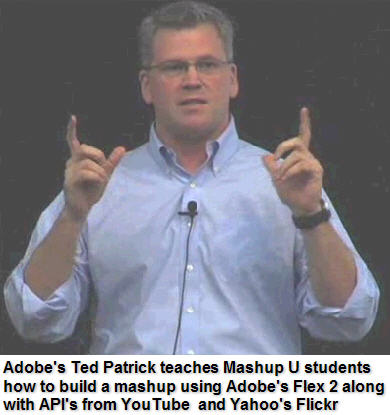Interested in learning how to develop mashups? Welcome to Mashup U. Online

My personal belief is that mashup style software development, as ecosytems go, will easily overtake most other software development ecosystems in number of developers and applications. To help acclerate that process, ZDNet, in conjunction with Mashup University (the event) now brings Mashup U directly to you, on your desktop at no cost to you.
There are a lot of different definitions of what a software mashup is (there are also other types of mashups, like music). But I stick to the one where the final piece of software is derived from the functionality and/or data of two or more disparate sources that have been woven together. In the press, the most often cited mashup is Adrian Holovaty's chicagocrime.org which takes the Chicago Police Department's database of crimes (and their locations) and superimposes them onto Google Maps. Adrian's mashup has got some incredible functionality built into the application. For example, you can narrow the view by zip code (eg: 60615), or by crime type (eg: kidnappings. Yes, they happen more often than you think).
I don't know of any other programming discipline that has attracted so many developes from so many walks of life so quickly. One reason for this is that you don't have to be a rocket scientist to join the mashup ecosystem. For most other development environments, you had to have some background in software development or be willing to make a substantial personal investment in learning how to develop software. But, while the mashup style of programming is attracted talented programmers like Adrian Holovaty, there are enabling tools out their that make it possible for ordinary people to develop them as well.
For example, Andrew Bidochko's mapbuilder.net makes child play out of building map-enabled mashups. Mapbuilder.net takes care of pretty much everything and Bidochko will even host your mashup. Fifth graders, for example, are using mapbuilder.net (and flickr) to show where some of the world's most famous explorers are from. Ning is another tool that puts the power of programming in the hands of ordinary people. With Ning, you don't need much more than a single click of your mouse to build a mashup. Why? Ning is full of mashup templates: either ones that Ning has preprogrammed for you to take advantage of or ones that other Ning users have developed. If you see a Ning-driven mashup that you like, with one click, you can clone it. Then, you can easily make some substitutions (eg: text) to personalize it to your needs.
Dating back to the early eighties when my career in tech started as a software developer, people always used to come to me with ideas for the next big thing that would make a million bucks and ask if I wanted to develop it. It was the perfect disconnect. There have always been millions of people with innovative ideas looking into the software industry like it was a fishbowl, unable to get in and swim. Now, with mashups, that's changing which is probably why this is going to be bigger than any other software ecosystem to come before it.
But to help people take the next step and actually write some code, Doug Gold and I put together a program called Mashup University. The first instance of Mashup U was a two-day training class that took place in July in Silicon Valley. The next one, with room for about 400 students, will be taking place at MIT in Cambridge, MA on January 15th and 16th (register for that and/or Mashup Camp on the 17th and 18th here). About 100 students attended that first run of Mashup U in July. But ZDNet's broadband group sponsored the event and did something very special with that sponsorship. For those students that couldn't attend, ZDNet filmed each class and did some fancy footwork from a post-production point of view, and put together what is essentially an online video distance learning version of Mashup U. What was fancy about the way this was post produced is that the edited version flips between camera-angles off the teachers, and real-time video captures of what's happening on their computer screens so you can see the actual code, stop the video, and try it yourself.
A while ago, when we were figuring all this out, we published one video. It was Brian Hamlin teaching Introduction to Mashups 101. Now, we have the remaining classes finished and over the next couple of days, I will be publishing blog posts that point to them under the category of Mashup University. The first of this next round of videos shows Adobe's Ted Patrick (pictured below) teaching Mashup U students how to build a mashup using Adobe's Flex 2 along with API's from Yahoo's Flickr as well as API's from YouTube.

Disclosure: In the spirit of media transparency, I want to disclose that in addition to my day job at ZDNet, I’m also a co-organizer of Mashup Camp, Mashup University, and Startup Camp. Adobe, which is mentioned in this story, was a sponsor of both Mashup Camp and Mashup University in July 2006. As a sponsor of Mashup University, ZDNet acquired the exclusive editorial rights to film and Webcast the content of Mashup University. For more information on my involvement with these and other events, see the special disclosure page that I’ve prepared and published here on ZDNet.